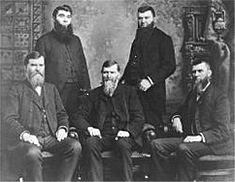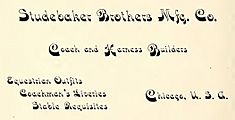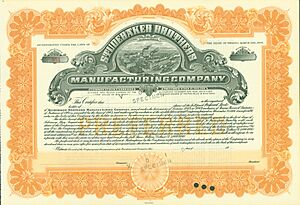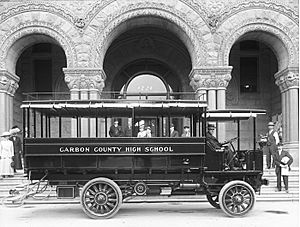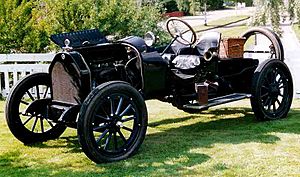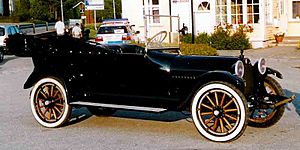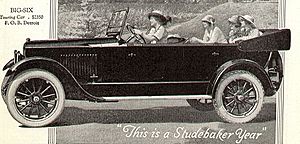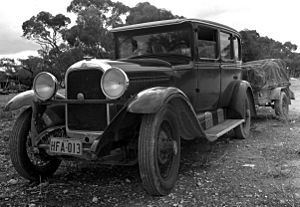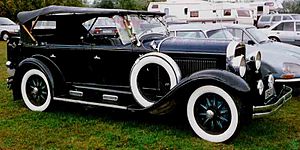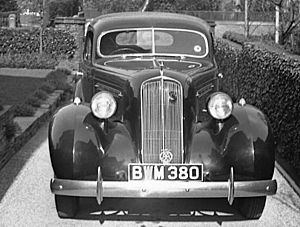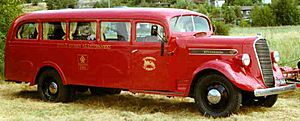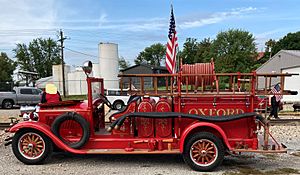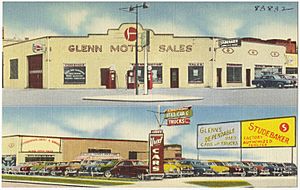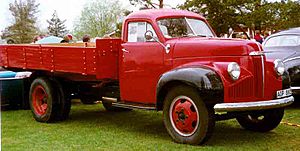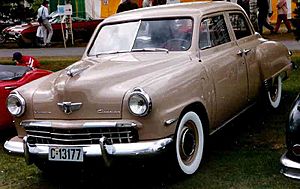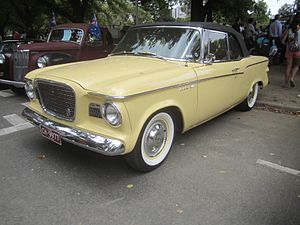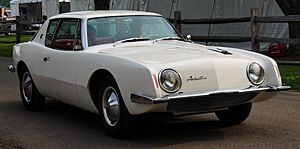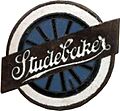Studebaker facts for kids
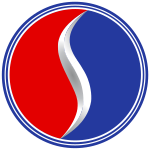
Badge used in the 1950s and 1960s
|
|
|
Formerly
|
Studebaker Brothers Manufacturing Company |
|---|---|
| Industry | Automotive, manufacturing |
| Fate | Merged with Packard to form the Studebaker-Packard Corporation Merged with Wagner Electric and Worthington Corporation to form Studebaker-Worthington Some naming and production rights, along with Studebaker's South Bend plant, acquired by the Avanti Motor Company |
| Successor | Studebaker-Packard Corporation Studebaker-Worthington |
| Founded | February 1852 |
| Founders |
|
| Defunct | November 1967 |
| Headquarters | 635 S. Main St., South Bend, Indiana, U.S. 41°40′07″N 86°15′18″W / 41.66861°N 86.25500°W |
|
Key people
|
|
| Products | Automobiles (originally wagons, carriages and harnesses) |
Studebaker was an American wagon and automobile manufacturer based in South Bend, Indiana, with a building at 1600 Broadway, Times Square, Midtown Manhattan, New York City. Founded in 1852 and incorporated in 1868 as the Studebaker Brothers Manufacturing Company, the firm was originally a coachbuilder, manufacturing wagons, buggies, carriages and harnesses.
Contents
History
German forebears
The ancestors of the Studebaker family descend from Solingen, Germany. They arrived in America at the port of Philadelphia on September 1, 1736, on the ship Harle, (see Exhibit B) from Rotterdam, Netherlands, (see Exhibit A, p. 11), original manuscripts now in the Pennsylvania State Library at Harrisburg). This included Peter Studebaker and his wife Anna Margetha Studebaker, Clement Studebaker (Peter's brother) and his wife, Anna Catherina Studebaker and Heinrich Studebaker (Peter's cousin). (see Exhibit A, p. 11) In 1918, Albert Russel Erskine, Studebaker Corporation president, wrote the book, "History of the Studebaker Corporation", including the 1918 annual report, "Written for the information of the 3,000 stockholders of the Studebaker Corporation, the 12,000 dealers in its products living throughout the world, its 15,000 employees and numberless friends." (see Exhibit A, p. 9) This book was verified by lawyers and accountants and all board members and was a legal document. (see Exhibit A, p. 7) In the same book, Albert Russel Erskin, accurately wrote that Peter Studebaker was the "wagon-maker, which trade later became the foundation of the family fortune and the corporation which now bears his name." (see Exhibit A, p. 11)
"The tax list of York County, Pennsylvania, in 1798–9 showed among the taxable were Peter Studebaker Sr. and Peter Studebaker Jr. wagon-makers, which trade later became the foundation of the family fortune and the corporation which now bears his name." (see Exhibit D) "John Studebaker, father of the five brothers [that began the Studebaker Corporation] was the son of Peter Studebaker. (see Exhibit A, p. 13). John Clement Studebaker (son of Clement Studebaker and Sarah Rensel) was born February 8, 1799, Westmorland, PA, and died in 1877 in South Bend, St. Joseph, IN. John Studebaker (1799–1877) moved to Ohio in 1835 with his wife Rebecca (née Mohler) (1802–1887).
The five brothers
The five sons were, in order of birth: Henry (1826–1895), Clement (1831–1901), John Mohler (1833–1917), Peter Everst (1836–1897) and Jacob Franklin (1844–1887). The boys had five sisters. Photographs of the brothers and their parents are reproduced in the 1918 company history, which was written by Erskine after he became president, in memory of John M., whose portrait appears on the front cover.
18th-century colonial family business
In 1740 Peter Studebaker built his home on a property known as “Bakers Lookout”. (The home still stands in Hagerstown, Maryland.) The first Studebaker wagon factory was built in the same year next to the home. On Bakers Lookout Peter, master of the German Cutler Guild, built the first Studebaker home, the first Studebaker wagon factory where he began forging and tempering steel and seasoning wood in the colonies. Peter Studebaker built the first Studebaker mill and a wagon road. Broadfording Wagon Road was built to run through the property. Peter owned property on both sides of the Conococheague Creek, so he built a bridge over the creek in 1747. Peter began the family business on the Bakers Lookout property where he made his home and built the first Studebaker wagon factory. In this factory, Peter manufactured everything, all necessities including products he made in Solingen, Germany, and naturally wagons. Bakers Lookout, the 1740, 100-acre land patent, Hagerstown, Maryland, was the first of many land patents to be acquired by Peter Studebaker. Peter purchased approximately 1500 acres in what is now known state of Maryland. The home still stands today and is proof of the advanced technology of Peter Studebaker. (see Bakers Lookout Peter Studebakers 1740 home website)
In 1747 Peter Studebaker built a road through his owned properties known as Broadfording Wagon Road. The road he built carried heavy traffic to Bakers Lookout's wagon and forging services that were instrumental to expand the west. The Maryland Historical Trust WA-I-306 writes 04/03/2001, that this road was "One of Washington County's earliest thoroughfares, Broadfording (Wagon) Road was already in existence in 1747." (see Exhibit I) The wagon transportation industry boomed. On the property, Broadfording Wagon Road built in 1740 by Peter Studebaker, went directly through the property to allow access from the home to the factory and to the mill.
Although Peter Studebaker's life in the colonies was short, less than 18 years, the family business flourished through his descendants (see Exhibit M) and apprentices expanded the vast land holdings enlarging the Studebaker family business and its industrious wagon-making region. Peter's trade secrets were passed from father to son, generation to generation. The Studebaker family business plan, purchasing, again and again, vast amounts of land, on which they built industrious farms with mills and wagon making facilities and wagon selling facilities, each identical to the Bakers Lookout situation, industrious farms, much acreage, on which one finds the necessary resources, lumber, iron ore, oil shale and land selected with stream, spring, or river to hydropower factories, mills and equipment. Peter's technology-enabled expansion of the family business through the famous Conestoga and Prairie Schooner wagon designs. Peter's trade was the stepping-stone that expanded the transportation industry. Thomas E. Bonsall, wrote "Much more than the story of a family business; it is also, in microcosm, the story of the industrial development of America." Peter Studebaker died in the mid-1750s.
End of horse-drawn era
John M. Studebaker had always viewed the automobile as complementary to the horse-drawn wagon, pointing out that the expense of maintaining a car might be beyond the resources of a small farmer. In 1918, when Erskine's history of the firm was published, the annual capacity of the seven Studebaker plants was 100,000 automobiles, 75,000 horse-drawn vehicles, and about $10,000,000 worth of automobile and vehicle spare parts ($194,557,522 in 2022 dollars ). In the preceding seven years, 466,962 horse-drawn vehicles had been sold, as against 277,035 automobiles, but the trend was all too clear. The regular manufacture of horse-drawn vehicles ended when Erskine ordered the removal of the last wagon gear in 1919. To its range of cars, Studebaker would now add a truck line to replace the horse-drawn wagons. Buses, fire engines, and even small rail locomotive-kits were produced using the same powerful six-cylinder engines.
Studebaker automobiles 1897–1966
In the beginning
In 1895, John M. Studebaker's son-in-law Fred Fish urged for development of 'a practical horseless carriage'. When, on Peter Studebaker's death, Fish became chairman of the executive committee in 1897, the firm had an engineer working on a motor vehicle. At first, Studebaker opted for electric (battery-powered) over gasoline propulsion. While manufacturing its own Studebaker Electric vehicles from 1902 to 1911, the company entered into body-manufacturing and distribution agreements with two makers of gasoline-powered vehicles, Garford of Elyria, Ohio, and the Everitt-Metzger-Flanders (E-M-F) Company of Detroit and Walkerville, Ontario. Studebaker began making gasoline-engined cars in partnership with Garford in 1904.
Studebaker marque established in 1911
In 1910, it was decided to refinance and incorporate as the Studebaker Corporation, which was concluded on February 14, 1911, under New Jersey laws. The company discontinued making electric vehicles that same year. The financing was handled by Lehman Brothers and Goldman Sachs who provided board representatives including Henry Goldman whose contribution was especially esteemed.
After taking over E-M-F's Detroit facilities, Studebaker sought to remedy customer dissatisfaction complaints by paying mechanics to visit each disgruntled owner and replace defective parts in their vehicles, at a total cost of US$1 million ($14,607,973 in 2022 dollars ). The worst problem was rear-axle failure. Hendry comments that the frenzied testing resulted in Studebaker's aim to design 'for life'—and the consequent emergence of "a series of really rugged cars... the famous Big Six and Special Six" listed at $2,350 ($34,329 in 2022 dollars ). From that time, Studebaker's own marque was put on all new automobiles produced at the former E-M-F facilities as an assurance that the vehicles were well built.
In 1913, the company experienced the first major labor strike in the automotive industry, the 1913 Studebaker strike.
Engineering advances from WWI
The corporation benefited from enormous orders cabled by the British government at the outbreak of World War I. They included 3,000 transport wagons, 20,000 sets of artillery harness, 60,000 artillery saddles, and ambulances, as well as hundreds of cars purchased through the London office. Similar orders were received from the governments of France and Russia.
The 1913 six-cylinder models were the first cars to employ the important advancement of monobloc engine casting which became associated with a production-economy drive in the years of the war. At that time, a 28-year-old university graduate engineer, Fred M. Zeder, was appointed chief engineer. He was the first of a trio of brilliant technicians, with Owen R. Skelton and Carl Breer, who launched the successful 1918 models, and were known as "The Three Musketeers". They left in 1920 to form a consultancy, later to become the nucleus of Chrysler Engineering. The replacement chief engineer was Guy P. Henry, who introduced molybdenum steel, an improved clutch design, and presided over the six-cylinders-only policy favored by new president Albert Russel Erskine, who replaced Fred Fish in July 1915.
First auto proving ground
In 1925, the corporation's most successful distributor and dealer Paul G. Hoffman came to South Bend as vice president in charge of sales. In 1926, Studebaker became the first automobile manufacturer in the United States to open a controlled outdoor proving ground on which, in 1937, would be planted 5,000 pine trees in a pattern that spelled "STUDEBAKER" when viewed from the air. Also in 1926, the last of the Detroit plant was moved to South Bend under the control of Harold S Vance, vice president in charge of production and engineering. That year, a new small car, the Erskine Six was launched in Paris, resulting in 26,000 sales abroad and many more in America. By 1929, the sales list had been expanded to 50 models and business was so good that 90% of earnings were being paid out as dividends to shareholders in a highly competitive environment. However, the end of that year ushered in the Great Depression that resulted in many layoffs and massive national unemployment for several years.
Facilities in the 1920s
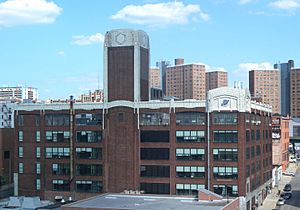
Studebaker's total plant area in Indiana was 225 acres (0.91 km2), spread over three locations, with buildings occupying 7.5 million square feet of floor space. Annual production capacity was 180,000 cars, requiring 23,000 employees.
The original South Bend vehicle plant continued to be used for small forgings, springs, and making some body parts. Separate buildings totaling over one million square feet were added in 1922–1923 for the Light, Special, and Big Six models. At any one time, 5,200 bodies were in process. South Bend's Plant 2 made chassis for the Light Six and had a foundry of 575,000 sq ft (53,400 m2), producing 600 tons of castings daily.
Plant 3 at Detroit made complete chassis for Special and Big Six models in over 750,000 sq ft (70,000 m2) of floor space and was located between Clark Avenue and Scotten Avenue south of Fort Street. Plant 5 was the service parts store and shipping facility, plus the executive offices of various technical departments. The Detroit facilities were moved to South Bend in 1926, except that the Piquette Avenue Plant (Plant 10) was retained for assembly of the Erskine between 1927 and 1929 and the Rockne (1931–1933).
Plant 7 was at Walkerville, Ontario, Canada, where complete cars were assembled from components that had been shipped from South Bend and Detroit factories or locally made in Canada, and is in close proximity to the current Ford Windsor Engine Factory. Output was designated for the Canadian (left-hand drive) and British Empire (right-hand drive) trade. By locating it there, Studebaker could advertise the cars as "British-built" and qualify for reduced tariffs. This manufacturing facility had been acquired from E-M-F in 1910 (see above). By 1929, it had been the subject of $1.25 million investment and was providing employment that supported 500 families.
Impact of the 1930s depression
Few industrialists were prepared for the Wall Street Crash of October 1929. Though Studebaker's production and sales had been booming, the market collapsed and plans were laid for a new, small, low-cost car—the Rockne. However, times were too bad to sell even inexpensive cars. Within a year, the firm was cutting wages and laying off workers. Company president Albert Russel Erskine maintained faith in the Rockne and rashly had the directors declare huge dividends in 1930 and 1931. He also acquired 95% of the White Motor Company's stock at an inflated price and in cash. By 1933, the banks were owed $6 million, ($135,640,103 in 2022 dollars ) though current assets exceeded that figure. On March 18, 1933, Studebaker entered receivership. Erskine was pushed out of the presidency in favor of more cost-conscious managers. Erskine died on July 1, 1933, leaving successors Harold Vance and Paul Hoffman to deal with the problems.
By December 1933, the company was back in profit with $5.75 million working capital and 224 new Studebaker dealers, while the purchase of White was cancelled. With the substantial aid of Lehman Brothers, full refinancing and reorganization was achieved on March 9, 1935. A new car was put on the drawing boards under chief engineer Delmar "Barney" Roos—the Champion. Its final styling was designed by Virgil Exner and Raymond Loewy. The Champion doubled the company's previous-year sales when it was introduced in 1939.
World War II
From the 1920s to the 1930s, the South Bend company had originated many style and engineering milestones, including the Light Four, Light Six, Special Six, Big Six models, the Dictator, the record-breaking Commander and President, followed by the 1939 Champion. During World War II, Studebaker produced the Studebaker US6 truck in great quantity and the unique M29 Weasel cargo and personnel carrier. Studebaker ranked 28th among United States corporations in the value of wartime production contracts. An assembly plant in California, Studebaker Pacific Corporation, built engine assemblies and nacelles for B-17s and PV-2 Harpoons. After cessation of hostilities, Studebaker returned to building automobiles.
Post-WWII styling
Studebaker prepared well in advance for the anticipated postwar market and launched the slogan "First by far with a post-war car". This advertising premise was substantiated by Virgil Exner's designs, notably the 1947 Studebaker Starlight coupé, which introduced innovative styling features that influenced later cars, including the flatback "trunk" instead of the tapered look of the time, and a wrap-around rear window. For 1950 and 1951, the Champion and Commander adopted a polarizing appearance from Exner's concepts, and were applied to the 1950 Studebaker Starlight coupe. The new trunk design prompted a running joke that one could not tell if the car was coming or going, and appeared to be influenced by the Lockheed P-38 Lightning, particularly by the shortened fuselage with wrap around canopy. During the war the Studebaker Chippewa Factory was the primary location for aircraft engines used in the Boeing B-17 Flying Fortress and the marketing department attempted to evoke a reference to their contribution to the war effort.
Exit from auto business
After an unsuccessful 1954 merger with Packard (the Studebaker-Packard Corporation) and failure to solve chronic postwar cashflow problems, the 'Studebaker Corporation' name was restored in 1962, but the South Bend plant ceased automobile production on December 20, 1963, and the last Studebaker automobile rolled off the Hamilton, Ontario, Canada, assembly line on March 17, 1966. Studebaker continued as an independent manufacturer before merging with Wagner Electric in May 1967 and then Worthington Corporation in November 1967 to form Studebaker-Worthington.
Legacy
While Studebaker closed fully its automotive sector in 1969, the company still left a big legacy behind it among classic car enthusiasts. The Studebaker US6 truck was the basis for the legendary GAZ-51 Soviet truck that was produced in the Soviet Union until 1975, nearly a decade after Studebaker had closed, and proceeded to form the basis for all GAZ trucks later, such as the GAZ-53, GAZ-3307 and 3309 and the GAZon Next.
The designers of the 1993 Dodge Ram stated that the Studebaker E series pickup was their main inspiration for the design.
Spectra Merchandising International, Inc. produces a number of "retro" styled audio equipment under the brand name "Studebaker."
Products
Studebaker automobile models
- Studebaker Electric (1902–1912)
- Studebaker-Garford (1904–1911)
- Studebaker Six monobloc-engine models (1911–1918)
- Studebaker Light Four (1918–1920)
- Studebaker Big Six (1918–1927)
- Studebaker Special Six (1918–1927)
- Studebaker Light Six (includes Standard Six model) (1918–1927)
- Studebaker Commander (1927–1935, 1937–1958, 1964–1966)
- Studebaker President (1928–1942, 1955–1958)
- Studebaker Dictator/Director (1927–1937)
- Studebaker Champion (1939–1958)
- Studebaker Land Cruiser (1934–1954)
- Studebaker Conestoga (1954–1955)
- Studebaker Speedster (1955)
- Studebaker Scotsman (1957–1958)
- Hawk series:
- Studebaker Golden Hawk (1956–1958)
- Studebaker Silver Hawk (1957–1959)
- Studebaker Sky Hawk (1956)
- Studebaker Flight Hawk (1956)
- Studebaker Power Hawk (1956)
- Studebaker Hawk (1960–1961)
- Studebaker Gran Turismo Hawk (1962–1964)
- Studebaker Lark (1959–1966) (Includes the Lark-based 1964–66 Cruiser, Daytona, Commander, and Challenger)
- Studebaker Avanti (1962–1964)
- Studebaker Wagonaire (1963–1966)
Studebaker trucks
- Studebaker GN series (1929–1930)
- Studebaker S series (1930–1934)
- Studebaker T series (1934–1936)
- Studebaker W series (1934–1936)
- Studebaker J series (1937)
- Studebaker Coupe Express (1937–1939)
- Studebaker K series (1938–1940)
- Studebaker M series (1941–1942, 1945, 1946–1948)
- Studebaker US6 (1941–1945)
- Studebaker M29 Weasel (1942–1945)
- Studebaker 2R Series (1949–1953)
- Studebaker 3R Series (1954)
- Studebaker E series (1955–1964)
- Studebaker Transtar (1956–1958, 1960–1964)
- Studebaker Champ (1960–1964)
- Studebaker Zip Van (1964)
- M35 2-1/2 ton cargo truck (1950s through 1964)
Studebaker body styles
- Studebaker Starlight (1947–1955, 1958)
- Studebaker Starliner
- Coupe Express
Affiliated automobile marques
- Tincher: An early independent builder of luxury cars financed by Studebaker investment, 1903–1909
- Studebaker-Garford: Studebaker-bodied cars, 1904–1911
- E-M-F: Independent auto manufacturer that marketed cars through Studebaker wagon dealers, 1909–1912
- Erskine: Brand of automobile produced by Studebaker, 1926–1930
- Pierce-Arrow: owned by Studebaker 1928–1934
- Rockne: Brand of automobile produced by Studebaker, 1932–1933
- Packard: 1954 merger partner of Studebaker
- Mercedes-Benz: Distributed through Studebaker dealers, 1958–1966
Advertisements and logos
-
1924 illuminated tiled display for Big Six touring car in Seville
See also
 In Spanish: Studebaker para niños
In Spanish: Studebaker para niños
- Automotive industry
- Charles Brady King
- List of defunct United States automobile manufacturers
- South Bend Watch Company (maker of Studebaker watches)
- Studebaker Canada Ltd.
- Studebaker National Museum
- Story Monument
- The Three Musketeers (Studebaker engineers)
- Turning Wheels magazine
- Tippecanoe Place


